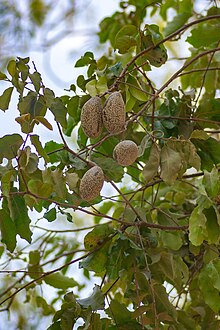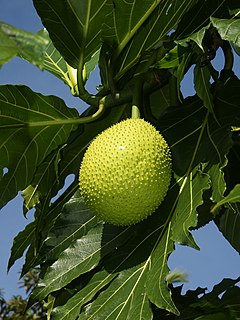
Breadfruit is a species of flowering tree in the mulberry and jackfruit family (Moraceae) believed to be a domesticated descendant of Artocarpus camansi originating in New Guinea, the Maluku Islands, and the Philippines. It was initially spread to Oceania via the Austronesian expansion. It was further spread to other tropical regions of the world during the Colonial Era. British and French navigators introduced a few Polynesian seedless varieties to Caribbean islands during the late 18th century. Today it is grown in some 90 countries throughout South and Southeast Asia, the Pacific Ocean, the Caribbean, Central America and Africa. Its name is derived from the texture of the moderately ripe fruit when cooked, similar to freshly baked bread and having a potato-like flavor.

The cashew tree is a tropical evergreen tree that produces the cashew seed and the cashew apple pseudofruit. The tree can grow as high as 14 m (46 ft), but the dwarf cultivars, growing up to 6 m (20 ft), prove more profitable, with earlier maturity and greater yields.

An orchard is an intentional plantation of trees or shrubs that is maintained for food production. Orchards comprise fruit- or nut-producing trees which are generally grown for commercial production. Orchards are also sometimes a feature of large gardens, where they serve an aesthetic as well as a productive purpose. A fruit garden is generally synonymous with an orchard, although it is set on a smaller non-commercial scale and may emphasize berry shrubs in preference to fruit trees. Most temperate-zone orchards are laid out in a regular grid, with a grazed or mown grass or bare soil base that makes maintenance and fruit gathering easy.

Ziziphus jujuba, commonly called jujube, red date, Chinese date, Chinese jujube, is a species in the genus of Ziziphus, in the buckthorn family (Rhamnaceae).

The jackfruit, also known as jack tree, is a species of tree in the fig, mulberry, and breadfruit family (Moraceae). Its origin is in the region between the Western Ghats of southern India and the rainforests of Malaysia.

Forbidden fruit is a name given to the fruit growing in the Garden of Eden which God commands mankind not to eat. In the biblical narrative, Adam and Eve eat the fruit from the tree of the knowledge of good and evil and are exiled from Eden.
And the Lord God commanded the man, saying, Of every tree of the garden thou mayest freely eat: But of the tree of the knowledge of good and evil, thou shalt not eat of it: for in the day that thou eatest thereof thou shalt surely die.

The damson or damson plum, also archaically called the "damascene", is an edible drupaceous fruit, a subspecies of the plum tree. Varieties of insititia are found across Europe, but the name damson is derived from and most commonly applied to forms that are native to Great Britain. Damsons are relatively small ovoid plum-like fruit with a distinctive, somewhat astringent taste, and are widely used for culinary purposes, particularly in fruit preserves and jams.

Averrhoa bilimbi is a fruit-bearing tree of the genus Averrhoa, family Oxalidaceae.

Annona glabra is a tropical fruit tree in the family Annonaceae, in the same genus as the soursop and cherimoya. Common names include pond apple, alligator apple, swamp apple, corkwood, bobwood, and monkey apple. The tree is native to Florida in the United States, the Caribbean, Central and South America, and West Africa. It is common in the Everglades. The A. glabra tree is considered an invasive species in Sri Lanka and Australia. It grows in swamps, is tolerant of saltwater, and cannot grow in dry soil.

The Egyptian fruit bat or Egyptian rousette is a species of megabat that is found in Africa, the Middle East, the Mediterranean, and the Indian subcontinent. It is one of three Rousettus species with an African-Malagasy range, though the only species of its genus found on continental Africa. The common ancestor of the three species colonized the region in the late Pliocene or early Pleistocene. The species is traditionally divided into six subspecies. It is considered a medium-sized megabat, with adults weighing 80–170 g (2.8–6.0 oz) and possessing wingspans of approximately 60 cm (24 in). Individuals are dark brown or grayish brown, with their undersides paler than their backs.

The orange is the fruit of various citrus species in the family Rutaceae ; it primarily refers to Citrus × sinensis, which is also called sweet orange, to distinguish it from the related Citrus × aurantium, referred to as bitter orange. The sweet orange reproduces asexually ; varieties of sweet orange arise through mutations.

Licania is a genus of over 200 species of trees and shrubs in the family Chrysobalanaceae. Species are found naturally occurring in Neotropical forests from southern Mexico to Brazil and the Lesser Antilles. Due to increased deforestation and loss of habitat, several species have declined, some markedly so, and L. caldasiana from Colombia appears to have gone extinct in recent years. Many species are either rare or restricted in distribution and therefore potentially threatened with future extinction.
Licania splendens is a tree in the family Chrysobalanaceae. The specific epithet splendens is from the Latin meaning "shining", referring to surfaces of the dried leaves.

Borassus flabellifer, commonly known as doub palm, palmyra palm, tala palm, toddy palm, wine palm or ice apple is native to the Indian subcontinent and Southeast Asia. It is reportedly naturalized in Socotra and parts of China.

The golden monkey is a species of Old World monkey found in the Virunga volcanic mountains of Central Africa, including four national parks: Mgahinga, in south-west Uganda; Volcanoes, in north-west Rwanda; and Virunga and Kahuzi-Biéga, in the eastern Democratic Republic of Congo. It is restricted to highland forest, especially near bamboo.
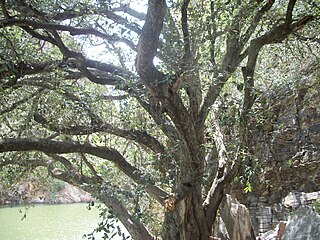
Licania rigida, the oiticica, is a species of plant in the family Chrysobalanaceae. It is endemic to Brazil and Puerto Rico. The oiticica grows deep in floods of rivers and streams, forming long, narrow avenues to the edge of ravines or floodplains staining the dark-green color of its large and dense foliage.
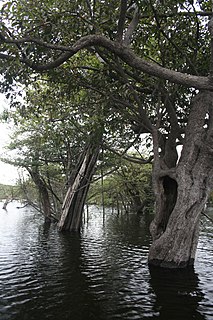
Igapó is a word used in Brazil for blackwater-flooded forests in the Amazon biome. These forests and similar swamp forests are seasonally inundated with freshwater. They typically occur along the lower reaches of rivers and around freshwater lakes. Freshwater swamp forests are found in a range of climate zones, from boreal through temperate and subtropical to tropical. In the Amazon Basin of Brazil, a seasonally whitewater-flooded forest is known as a várzea, which is similar to igapó in many regards; the key difference between the two habitats is in the type of water that floods the forest.
Licania michauxii, commonly known as gopher apple, is an evergreen shrub. It grows in the sandhills of peninsular Florida as well as coastal Mississippi and Georgia. Its fruit is eaten by wildlife and is being used in cancer research. The fruit is a food source for the gopher tortoise.
Monkey apple is a common name for several plants and may refer to:
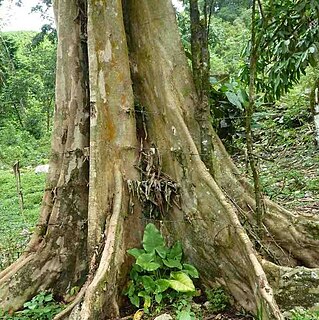
Licania platypus, also known as sun sapote, sansapote, sonzapote, sunzapote, sungano, zapote cabelludo, sapote, sangre, zapote amarillo, zapote borracho, zapote cabello, zapote de mico, zapote de mono, mesonsapote, mezonzapote, cabeza de mico, caca de nino, sonza, sunza, zunza, chaute jolobob, urraco, chupa, and monkey apple, is a flowering tree in the family Chrysobalanaceae.
